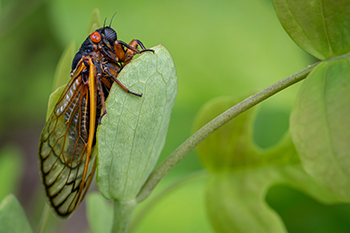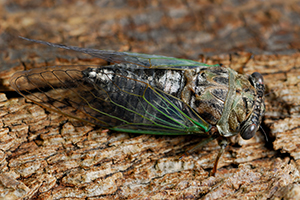The Great Southern Brood

By Bill Steinmetz
May 14, 2024
- Brooding in the south
- Parties weren’t meant to last
- Cicadas and your favorite young plantings
Cicadas have surfaced in abundance as Brood XIX members (Magicicada species – 13-year return), also known as the Great Southern Brood, emerge in the Triangle and the southeastern United States. The buzzing, droning, and clicking sounds, which can be heard on the NIEHS Campus, are produced by cicadas to attract, or dismiss potential mates.

These periodical cicadas will be enjoying a strength in numbers approach to survive various predators and produce the next generation. This saturation tactic by trillions of cicadas prevents predators such as cicada killing wasps, birds, dogs, humans, and other mammals from significantly reducing the population.
With a four to six-week lifespan, mortality approaches quickly for the cicadas, but not before females lay eggs in tree branches and the hatched nymphs fall to the ground and burrow into the soil to begin another 13-year cycle of southern brooding.

Cicadas do not sting or bite and will not cause property damage. Crunchy exoskeletons can be easily removed from walkways and structures. In addition, cicadas are unlikely to cause major plant damage. However, gardeners may consider protective netting for young woody plants including tree saplings, blueberries, and grapevines if cicadas are abundant near the garden area.
Note: Our annual cicada (Neotibicen canicularis), which is a variety present across central North Carolina will also emerge this year, in lesser numbers, most likely during the July – August timeframe.
See this previous article for additional information about cicadas.



